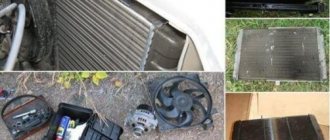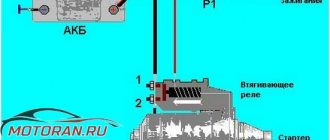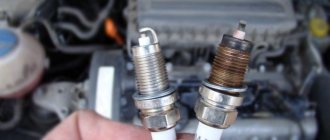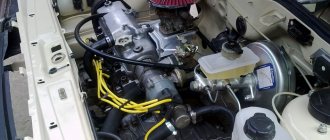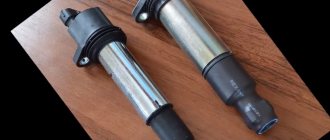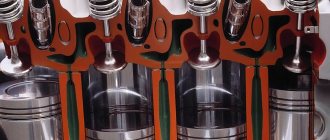The situation when the engine does not heat up to operating temperature is quite common in gasoline and diesel cars. At the same time, many car owners do not pay due attention or do not notice this malfunction at all, especially in the warm season. The reason is simple - drivers are more afraid of overheating, but not everyone knows about the consequences of driving on a cold or insufficiently warmed up engine. So it turns out that if a gasoline or diesel engine does not reach operating temperature, the arrow of the temperature indicator on the dashboard does not reach the desired value on the scale, you can still drive. However, it should be taken into account that engine wear increases, the fuel appetite of the unit increases, the exhaust becomes toxic, the engine “pulls” worse, etc.
Typically, problems that cause the engine temperature not to rise become relevant with the onset of cold weather. The main sign of a problem is deterioration in the operation of the stove. In other words, the operating comfort of the vehicle decreases due to the low temperature in the cabin, which forces the driver to take action. Next we will talk about what to do if the engine operating temperature is low, the engine takes a long time to warm up to operating temperature, etc.
Read in this article
Why is it necessary to warm up the engine?
Warming up the engine began in the last century, when the vehicle was moved after the engine had reached the desired temperature. Warming up occurs at idle speed. Before moving, you need to wait a few minutes so that the motor does not stop along the way. All parts warm up and function normally. Warming up is necessary to ensure normal engine operation, narrowing the gaps between parts, maintaining the required viscosity of the engine oil and reducing fuel consumption.
Air in the system
To displace the air, you need to drive the front of the car up the hill and leave the engine running at idle for a few minutes. During the procedure, periodically flush the pipes. Immediately after replacing the thermostat, periodically check the antifreeze level. After removing the air pockets, add coolant if necessary.
Coolant supply system
Checking the functionality of the thermostat
The design of the device implies sensitivity to changes in temperature. The pressure in the coolant system does not affect the restriction of antifreeze circulation through the small circuit, cylinder head and block cooling space. As the temperature difference between the engine and the environment increases, the thermostat gradually opens the coolant supply from the main radiator to the engine.
The same thing happens when the difference in indicators decreases. This process helps maintain and limit the temperature limit of the engine, as well as heat the interior of the car. To determine if the thermostat is working properly, you do not need to remove it.
You can detect a breakdown manually when starting the engine. When it has warmed up for 5 minutes, you can check the device.
Starting will cause coolant to circulate through the engine's cooling passages. Heating of the coolant begins in the engine and radiator of the car. The pipe going in the opposite direction from the radiator to the engine should not be hot. If this happens, then there is a problem with the thermostat.
Principle of operation
Coolant enters the radiator through the thermostat. This is a large circle of fluid circulation. The thermostat usually opens at a temperature of 100 degrees Celsius. If the temperature has not reached this limit, then the liquid moves in a small circle. A thermostat malfunction is manifested by improper opening of the valves.
When the thermostat is closed, the engine overheats, and a constantly open one leads to low temperatures, since the liquid will only flow in a large circle.
Due to irregular changes of antifreeze or antifreeze, use of running water or mixing of coolants, various deposits in the form of scale may accumulate in the system. In this case, the thermostat will inevitably jam in one of its positions.
Causes of the problem and consequences
There are many sources of the problem. The engine takes a long time to warm up in the following cases:
- presence of ice or air lock in the cooling system;
- poor quality antifreeze or incorrectly selected product;
- thermostat failure;
- problems with temperature sensors;
- poor quality oil or incorrectly selected lubricant.
Failure to properly warm up the car can lead to negative consequences, including:
- Possibility of costly repairs. Wear can lead to motor seizure or other damage.
- Problems with the cooling system. The devices it consists of can operate under normal conditions. Changes in temperature can negatively affect the functioning of sensors, thermostats and other parts.
- Reduced engine power level. Engine efficiency decreases with increasing flow rate and element load.
- Wear of motor components. At constant low temperatures there is a risk of breakdown and the need for major repairs.
- Increased fuel consumption.
Warming up the power plant must be carried out regularly and for a long time, otherwise the car will not work normally.
The engine does not warm up to operating temperature: consequences
On the dashboard of modern cars, a special scale is provided to monitor engine temperature. The driver can observe at what temperature the motor operates, from which to draw appropriate conclusions. If, during prolonged operation of the engine, its temperature does not reach the optimal 85-90 degrees, it is necessary to understand the causes of the malfunction as soon as possible.
Operating a car with a supercooled engine will not lead to anything good. The following problems can be identified that await the driver if the engine does not warm up to operating temperature and operates in this mode for a long time:
- Increased fuel consumption. The fact is that the electronic control unit is responsible for the amount of fuel injected in modern cars. If the engine does not reach operating temperature, the ECU recognizes it as cold and issues a command to inject a rich mixture;
- Increased carbon deposits on engine components (in particular, spark plugs) and an increased risk of coking;
- Reduced engine power characteristics due to engine operation not in optimal mode;
- Low efficiency of lubricating components, which leads to increased friction and increased wear.
We recommend: Do-it-yourself Lada Kalina station wagon - reviews and Logbooks on DRIVE2
Constant operation of the engine in a non-optimal temperature state can quickly damage it and lead to the need for major repairs.
The engine does not reach operating temperature
You can monitor the temperature readings of the power unit directly from inside the car. The dashboard of all modern cars has a small information field, usually round or semicircular in shape, showing the driver the coolant temperature readings. This is the device that gives an idea of the temperature conditions in which the engine is operating at a given time.
If the temperature gauge does not reach 90 degrees during a long trip, you should seriously think about finding the cause of the deviation from the normal operation of the power unit. It is not recommended to delay its diagnosis, because prolonged operation of the motor in this mode will lead to wear of its internal components.
The fact is that the electronic control unit, which is popularly called the “brains” of the car, recognizes an engine that has not reached the nominal temperature as cold, and therefore the fuel system injects an over-enriched mixture.
Working in this mode leads to heavy carbon deposits on the spark plugs and, accordingly, on the internal elements of the engine, which in the future will lead to the need for a major engine overhaul.
What can be done?
If the car is not warming up well, you can inspect the thermostat yourself.
Removing the air tube
The main reasons for poor heating in winter include air lock. It is useful for a car driver to have the knowledge and skills to remove air from the system. Its accumulation occurs at the highest point - the throttle assembly. From there you need to remove the air plug. The sequence of actions is as follows:
- Unscrew the filling cap on the engine, remove the screen and screw the cap into place to avoid contamination of the crankcase.
- Find 2 pipes, which are located side by side in the throttle assembly, and pull out 1 of them.
- Open the coolant expansion tank and cover it with a clean cloth.
- Blow slowly into the tank until antifreeze flows out of the hose.
- Put the tube back on and tighten the clamp quickly so that no air gets into the pipe.
This scheme is suitable for the VAZ 2114. When clogging of the cooling paths occurs frequently, check the entire system, which may be depressurized. If after these steps the engine temperature does not rise, then you need to look for another source of problems.
Engine insulation
By insulating the engine, you cannot get rid of all problems with warming up. If the engine is properly insulated, it will not require prolonged warming up during the day, and the coolant temperature will be normal. To insulate domestic equipment, heat-insulating material is installed between the radiator and the front grille. The motorist can use cardboard or buy special insulation.
In a purchased product, the padding consists of synthetic insulation covered with a leather substitute. It has the advantage of special holes that open when the temperature rises. Insulation can be achieved by installing a heat insulator under the hood. Special blankets have been developed for this purpose.
You can buy them or make them yourself from felt, mineral wool or other material. This type of thermal insulation helps prevent a layer of ice from freezing on the hood, which often happens in winter when snow falls on the car, melts and freezes. The heat insulator can be glued to the lower engine protection. In the future, it will need to be cleaned of dirt so that it does not get into the engine.
What can be dangerous about a cold engine?
If you notice that the engine has not warmed up to operating temperature and it cannot rise, then you should start immediately troubleshooting, as the consequences can lead to serious expenses for repairs.
The electronic control unit installed on modern cars recognizes an unheated engine as a cold one. If it cannot warm up and the engine temperature does not rise, then an over-enriched mixture is supplied.
When the system has to operate in this mode, the spark plugs fail due to the appearance of carbon deposits on them and on the internal elements. Thus, you can significantly reduce the service life and face major repairs, which cost a lot of money.
If the engine does not warm up to operating temperature, you should immediately contact a car service to diagnose the problem so that similar malfunctions do not occur in the future.
Why does the engine not warm up to operating temperature?
If the car engine does not warm up to 90 degrees during operation, it is necessary to urgently check its cooling system; most often the problem is related to it. The following faults can be identified that can lead to this kind of problem:
- Thermostat is not working properly. In a car engine, the thermostat is responsible for switching the direction of coolant flow. When the engine just starts, the coolant in it moves in a small circle, warming the engine up to operating temperature. When the engine temperature reaches approximately 90 degrees, the thermostat switches the direction of coolant flow to a large circle. If the thermostat gets stuck and does not fulfill its direct duty of switching the direction of coolant flow, this can lead to both overheating and overcooling of the engine. Accordingly, you need to check the thermostat, and if it is faulty, you will need to replace it with a new one;
- Air is sucked in through the pipes. If the pipes are not tightened properly, additional air from the atmosphere may enter the system. Most often, if there is a similar problem, you can see traces of coolant on the pipes, which partially flows through them. In such a situation, you need to tighten the clamps better and check the pipes for cracks and tightness;
- Error in the operation of the coolant temperature sensor. If the sensor provides incorrect information, the driver may be misled by the information displayed on the instrument panel. The scale will indicate that the engine is not warming up enough, although in fact this may not be the case. To avoid the possibility of this type of problem, you need to check the coolant temperature sensor and replace it if there are deviations from optimal results.
Above are the three most common reasons why the engine does not warm up to operating temperature (or the driver believes that the engine is not warm enough). In 95% of cases, the problem is related to the thermostat, which is recommended to be changed every 3 years or every 50 thousand kilometers.
Effect of motor oil
As you know, engine performance depends on the quality of the oil. The degree of heating of the engine will depend on this, especially in winter. Depending on what kind of oil is used (synthetic or semi-synthetic), the engine may heat up differently, and the range of fluctuations in coolant temperature will be from 5 to 20 degrees.
Depending on how liquid the motor lubricant is, how well and quickly the engine will start in winter, as well as the degree to which it heats up quickly. Therefore, it is recommended to fill only high-quality oil into the engine before winter.
Other reasons
A malfunctioning thermostat may not be the only reason why the engine does not reach operating temperature.
If the pipes were not tightened well during the previous repair, the car owner is faced with air leaks. Coolant begins to leak. If this is the problem, then you should tighten the clamps for a tighter fit of the tubes and add fluid to the required level in the expansion tank.
In this case, the car owner will see a low temperature on the dashboard, which is insufficient for operation. In fact, the engine will overheat and may even boil.
During the winter season, engine performance is also affected by the use of other systems. So, using a cabin heater can lead to the engine not heating up well, since the stove takes some of the heat onto itself. In this case, you will see how the arrow of the engine temperature indicator drops.
A faulty temperature sensor can cause the engine to feel like it takes a long time to warm up or may not heat up at all. In this case, the engine works properly. The sensor transmits temperature status data to the dashboard. If it does not work correctly, then the readings will be incorrect. Replacing this part will bring all indicators back to normal.
We recommend: What function does the timing chain perform?
The problem with the sensor is quite serious on modern cars equipped with electronics. Here again you will have to deal with supplying an over-enriched mixture and replacing many other parts.
Any problem that arises must be resolved with the help of a competent specialist. If you do not have the necessary knowledge and skills, you should contact a car service center. Experienced technicians will help eliminate the problem and prevent its occurrence in the future.
The main reasons for insufficient heating of the internal combustion engine
Thermostat stuck open
A common cause of insufficient engine temperature is a stuck thermostat.
One of the common causes of this problem is a stuck thermostat in the slightly open position. This may occur due to a foreign object getting under the valve: a piece of sealant, scale, scale. Also, the thermostat becomes unusable after a certain period of use. As a result, the coolant begins to circulate in a large circle rather than in a small one. The solution to this situation is to replace the jammed part. The next reason for the engine not warming up to operating temperature is the time of year.
Warming the engine in winter
The most unpleasant cause of low engine temperature is damage to the cylinder block gasket.
In winter, especially in severe frosts, the internal combustion engine may have insufficient temperature. To eliminate the problem, it is necessary to perform additional insulation of the engine. The answer to the question is sometimes hidden in the discrepancy between the brand of coolant and the manufacturer’s recommendations. If this is the reason, then it is enough to change the fluid to the desired one. The most serious reason why the engine temperature does not rise above 80 degrees is a damaged cylinder head gasket. Because of this problem, exhaust gases begin to enter the cooling system, which leads to a violation of the temperature regime. Causes of gasket damage include engine overheating or a thermostat that is stuck in the closed position.
The engine temperature arrow does not rise, the engine temperature fluctuates, the engine cools down while driving
The time it takes for the engine to warm up to operating temperature may vary for each serviceable unit. This happens due to the fact that heating and its intensity depend on a number of conditions. The warm-up speed can be affected by the degree of engine boost, its type (gasoline/diesel), the general condition of the cooling system, the quality of the antifreeze or antifreeze poured in, the outside temperature, the degree of load while driving, the intensity of the heater in the cabin, and so on.
Let us add that many experts agree that different types of motor oils and their viscosity can also affect the overall heating of the engine, although only slightly. The operating temperature of the oil in a conventional engine is around 100-150 degrees, not exceeding the maximum threshold of about 200 degrees (all indicators are averaged). In parallel with this, the maximum oil temperature in the engine is determined by the flash point of the oil, its coking, etc.
It may seem that the temperature range will be the same for different oils, but this is not the case. Special additive packages that reduce friction losses and the base itself (synthetic, semi-synthetic) affect the degree of oil heating. In other words, low-viscosity oils cool rubbing couples better, but the lubricant itself heats up more. It turns out that with different engine oils, the temperature in the crankcase of the same internal combustion engine can differ by 5-7 degrees. If we take into account these features, then we can assume that with “liquid” synthetics, the engine will not only be easier to start in winter, but will also warm up faster.
So, let's return to the cooling system. A cold engine and a non-working heater in most cases are the consequences of thermostat malfunctions. If you notice that the power unit takes a very long time to heat up, the engine does not warm up to operating temperature, and the engine temperature gauge needle drops while driving, then you should start checking with this device.
The thermostat allows heated coolant to enter the radiator. This circulation through the radiator is called a large circle. The thermostat opens strictly at a certain temperature on different internal combustion engines (on average about 90 degrees Celsius), that is, up to the specified value, the liquid circulates only in a small circle. Problems begin when the thermostat stops opening or closing in a timely manner. If it does not open, then the engine overheats. If the thermostat is open all the time, the antifreeze will constantly circulate only in a large circle, and the engine will not warm up to operating temperature.
The thermostat jamming, both open and closed, occurs due to the accumulation of scale and other deposits in the cooling system. The reason is irregular changes of antifreeze or antifreeze every 3 or 4 years, mixing coolants with each other, using running water in the cooling system, ignoring the need to flush the system.
We also recommend reading the article on how to flush the cooling system yourself at home. From this article you will learn about various methods and means for flushing the engine cooling system with your own hands.
To check the thermostat, start the cold engine and let the unit idle for 5-10 minutes. Then you should feel with your hand the upper and lower hoses going to the radiator. If the thermostat is in good condition, then the pipes should not be heated. In other words, the coolant does not enter the large cooling system circuit until the liquid warms up to a temperature that is the opening temperature of the thermostat on a particular engine. In practice, this looks like this: the temperature arrow on the dashboard should rise, warm or even hot air should come out of the air deflectors, but the radiator pipes remain cold. Once the pointer reaches operating temperature, the thermostat should open. After this, the hot liquid will flow through the pipes in a large circle into the radiator, heating the indicated elements. It turns out that if the radiator and pipes immediately warm up after starting a cold engine, then the thermostat does not close the large circle, that is, its malfunction is obvious.
It is more difficult to determine a breakdown when the device opens or closes, but not completely. In such a situation, there may be partial overheating or insufficient heating of the motor. There are also cases when the thermostat does not jam constantly, but only periodically. In any case, the element must be removed, defective, repaired or completely replaced. On different engines, the location of the thermostat may differ. On some motors, access to the element can be very difficult. Usually the device is located in the place where the upper radiator hose approaches the engine. Less common are designs where the installation location is the area where the lower hose is supplied.
We recommend: Arranging the exterior of your car
It should also be noted that to remove the thermostat, the liquid from the cooling system must be drained. We talked about how to do this in the article about flushing the cooling system. After removal, it is necessary to carefully inspect the thermostat, taking into account the features of its design. This is necessary for the correct selection of the appropriate analogue. On most engines, the thermostat opens a large circle, after which the coolant circulates through both the small and large circuits simultaneously. The engine is cooled due to less resistance to fluid flow in the large circuit compared to the small circuit. There are also thermostats that, when activated, open a channel in their housing, while simultaneously closing the channel in the engine block. This design allows the small circle to be closed, forcing the working fluid to circulate only along the large circuit through the radiator.
As for the selection of the thermostat itself, the following basic parameters should be taken into account when choosing it:
- physical size;
- response temperature;
- manufacturer;
Car manufacturers use thermostats from well-known companies, so there should be no problems with selecting a device. It should also be taken into account that very often thermostats of a particular brand can be interchangeable. For example, on GM cars, thermostats for one model can be successfully installed on another. As for the response temperature, it is usually stamped on the device body. It is advisable to install a new element with a similar characteristic so that the thermostat does not turn out to be too “cold” or “hot” on a particular engine.
The engine temperature gauge does not rise: why is it dangerous?
Let's start with the fact that normally the temperature of many internal combustion engines after warming up should not exceed, on average, 90 degrees. This temperature regime is optimal. Slight fluctuations of the needle are also allowed if the car is stuck in a traffic jam in the heat or is moving along the highway at high speed in severe frosts.
In the first case, the temperature may rise briefly (usually before the cooling fan turns on). In the second, cold air cools the radiator too intensively, as a result of which the engine cannot fully reach operating temperature.
At the same time, a situation is also common when external factors cannot in any way influence the heating of the power unit, but the temperature indicator on the instrument panel still does not rise. Also, on some cars there may be no dial indicator, and the coolant temperature readings are displayed digitally.
One way or another, if the temperature needle or digital indicator does not show heating up to 90 degrees even after a long drive, this indicates certain violations of the temperature regime.
It is important to understand that troubleshooting in this case must be done as soon as possible, since operating the engine in underheating mode disrupts the combustion processes of the fuel-air mixture, increases exhaust toxicity and leads to accelerated wear of power plant parts.
In a nutshell, on injection cars, the ECU records the engine temperature, and the engine is determined by the block as cold. As a result, the “brains” enrich the mixture. Working with an over-enriched mixture leads to the formation of carbon deposits, the spark plugs become dirty, the combustion chamber becomes coked, etc.
The engine temperature arrow does not rise: reasons
So, if the driver notices that when driving the engine does not warm up to operating temperature, it is necessary to check the cooling system. Typically, diagnostics of its elements allows you to determine why the engine temperature does not rise.
You should start with tightness. As a rule, insufficiently tightened clamps on the pipes lead to air leaks and the formation of air locks in the cooling system. Also, antifreeze or antifreeze can leak through leaks or defects in tubes and pipes, which leads to a decrease in its level in the expansion tank.
- The next element is the thermostat. In short, this is a device that passes coolant after it has warmed up from a small circle to a large one. The large circle involves circulation through the cooling radiator, and the small circle involves coolant circulation only through the cooling jacket (channels in the cylinder block and cylinder head).
After the coolant in the cooling jacket heats up to 80-90 degrees Celsius, the thermostat opens, allowing liquid to flow into a large circle (through the radiator). If the thermostat gets stuck in the open position, then the liquid will constantly circulate in a large circle, which will not allow the engine to heat up.
Determining such coolant circulation is quite simple. After parking, you can start the engine, then you need to let it run for about 5-7 minutes. Next, you should feel with your hand the lower pipe going to the radiator. If the pipe is warm, this means that the thermostat is stuck in the open position.
Then you can probe the upper radiator hose, assessing the degree of its heating compared to the lower one. If this pipe is also warm (the heating of the upper and lower pipes is the same), this confirms the fact that the thermostat has failed.
Please note that there is no point in trying to repair the thermostat. The problem is solved by replacing the thermostat. When choosing a new device, you should select a thermostat so that the operating temperature is recommended for this type of engine.
- If checking the cooling system does not reveal anything, then the fault may lie in the electrical part. We are talking about the engine coolant temperature sensor (ECT).
The specified thermocouple sends a signal both to the ECU and displays readings on the instrument panel. In the first case, this can directly affect the operation of the internal combustion engine, while in the second, the engine itself is operating normally (the engine is hot), but according to the readings on the dashboard, the engine is cold.
We also recommend reading the article about why the car engine does not warm up to operating temperature. From this article you will learn about what problems can cause the power unit to only partially warm up and not reach operating temperature.
In any case, for normal operation of the internal combustion engine and accurate temperature control, the DTOZh must be checked and replaced with a serviceable one if necessary.
Note that if the sensor sends incorrect signals, the cooling fan may also operate even on a cold engine. We should not exclude the possibility of damage to the indicator itself on the instrument panel, as well as damage to the electrical circuits that connect the indicator and the sensor.
By the way, this version is easy to check. It is enough to turn on the stove in the cabin to maximum and assess the degree of heating. If hot air is coming from the heater, but according to the readings on the dashboard the engine is cold, then the problem is obvious. It also happens that the engine temperature needle in this case jumps or jumps chaotically.
- The ECU itself completes the list of possible problems. This happens rarely, but the possibility also exists. In practice, some cars are designed in such a way that the opening of the thermostat is controlled by a control unit. The controller can also send a signal to the instrument panel.
As a rule, such consequences can be caused by water entering the engine control unit, short circuits, unqualified chip tuning (reflashing the control unit), etc. In any case, it is necessary to diagnose the engine control unit using special equipment.
Let's sum it up
In this article, we examined one of the most common reasons why the engine does not warm up, may cool down while driving, the engine temperature does not rise above 70 degrees, etc. Let us add that in the latter case, on a car with an unknown history, it often turns out that the previous owner had previously installed a too “cold” thermostat. In parallel with this, other malfunctions of the cooling system may occur, as a result of which the internal combustion engine does not heat up.
It should also be noted that repairing the device is impractical given its relatively low cost. For this reason, instead of descaling the thermostat and trying to eliminate its jamming, it is better to immediately install a new element on the machine.
Sources
- https://autochainik.ru/dvigatel-ne-progrevaetsya.html
- https://avtodvigateli.com/neispravnosti/ne-progrevaetsya.html
- https://okeydrive.ru/pochemu-dvigatel-ne-progrevaetsya-do-rabochej-temperatury/
- https://KrutiMotor.ru/dvigatel-ne-nagrevaetsya/
- https://www.avtovzglyad.ru/sovety/ekspluataciya/2020-09-30-chto-delat-esli-dvigatel-perestal-progrevatsja-do-rabochih-temperatur/
How to fix the problem
The logical solution to the problem, in this case, is to replace either the thermostat itself or the component thermoelement. Both options are quite cheap, since we are talking about a domestic manufacturer, there is no need to buy any analogues. This procedure can easily be carried out independently, but if you do not know the technical component of the VAZ-2110, it is still better to contact specialists at service stations. The most important thing is to first drain all the antifreeze in the system.
As a result of the replacement, the car’s instrument scale should show an engine temperature of at least 90 degrees after 20-30 minutes of warming up or 10-15 minutes of driving without prior waiting. The thermostat scale must be monitored periodically, at least once every 15 minutes of travel. A quick glance is enough to ensure that the engine temperature is within the required range, which will automatically indicate the integrity and suitability of the thermostat itself.
Long warm-up can also be a consequence of incorrectly selected antifreeze for the cooling system, but such cases, as practice shows, are rare.


